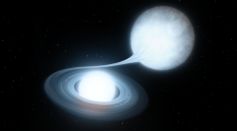Tags: Supernova

Why Is Earth Sitting in the Center of a ‘Local Bubble’ Surrounded by Baby Stars? Here's What Experts Say

Red Supergiant Star Transforms Into Type II Supernova as Scientists Watch Real Time

Astronomers Discover the Fastest Optical Flash of Type Ia Supernova that Helps Discover Accelerating Expansion of Universe

Here's How Scientists Depend on Isolated Stars to Examine Weak Supernova Explosions

Origins of Heavy Metals: Researchers Use Computer Simulations to Determine Where Gold Comes From

Supernova Remnant: Red Ribbon Explosion of a Dead White Dwarf Inside the Large Magellanic Cloud Captured by Hubble Space Telescope
NASA Hubble Space Telescope Now 'Partially' Fine After Glitch; Shares Photo of Cosmic Gas Ribbon

Stars of Galaxy Charted 12 Billion Light-Years Away Contains Same Element Inside Human Bones, Toothpaste
Hubble Space Telescope Found Two Interacting Galaxies 200 Million Light-Years Away
Researchers Successfully Recreates Supernova Reaction In a Lab Using an Accelerated Beam of Radioactive Nuclei
NASA Hubble Space Telescope Witnesses Death of a Star; Is This a Warning Sign?
Chinese Supernova Seen 900 Years Ago Finally Solved: Is SN 1181 a Zombie Star?
Light From Exploding Supernova Requiem Will Be Seen Again in 2037, Astronomers Say

Did a Black Hole Cause a Rare, Premature Supernova? Scientists Explain How It Happened
Star Factories Are Major Polluters of the Universe, Study Showed
Supernova Blast Captured: Kepler Space Telescope Reveals the Groundbreaking Data It Recorded 3 Years Ago
Protons, Electrons Comprise Gamma Ray; Origin Identified for the First Time, Quantified in Cluster of Supernova Remnant
Supernova or Partner Star Effect? White Dwarf With Heavy Metals Blasts Opposite and Out of the Milky Way

This Supernova Shrapnel Star Is Running Away From The Galaxy, 2M Miles an Hour
Beauty After Star Explosions: NASA Shares Photo of 300-Year-Old Cassiopeia A, Supernova Remnant
Most Popular

Can EV Batteries Be Recycled? How Lithium Recovery Supports Sustainable Batteries

Coral Bleaching Crisis: How Ocean Warming Threatens Marine Ecosystems Worldwide

V2G Technology: How EV Energy Storage Utilizes Smart Grid and Renewable Energy Integration

El Niño and La Niña Explained: How Climate Cycles Drive Extreme Global Weather Patterns





